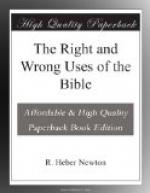The nation found the times ripe at last for the final process of this historic evolution; the dead cerements of Judaism fell apart, and thereout bloomed that perfect flower of religion, the religion of the Christ, simple, free, ethical, spiritual. The extant literature of this last creative effort of Israel constitutes the New Testament. The Gospels tell the story of the life of the Founder of Christianity, clearly enough in the main outlines, and embalm many of the words and deeds of the Son of Man. The other writings of the New Testament illustrate the working of the thought and spirit of the Christ in the Church bodying around Him through the growth of a century. In them we see that the long cherished ideal of Israel, an Ethical and Universal Religion, had at last incarnated itself in The Master whose plans laid the foundation of this new Order; into which men were coming from the east and from the west, and from the north and from the south, and were sitting down in the Kingdom of God.
The high-water mark of religion in human history is recorded in these writings. To enter into the spirit of these writings is to feel the force of the free, full tides of ethical and spiritual life which rose, as never before nor since, in the dawning day of Christianity. The flow of such a force within the individual soul and through society has been the power of the New Testament in Christendom.
8. This organic growth of a national religion into a catholic ideal, not without parallels elsewhere, is, however unique in respect to the conditions for a truly Universal Religion.
The scene of this evolution is not the heart of the East, as in Buddhism, but the meeting point of East and West. Palestine is the race centre of the earth. Camels unload in Jerusalem the goods laden upon them in the seats of the most ancient empires; and on her pebbly beaches the Mediterranean rolls, bearing the commerce of Europe. Behind Judea lies the past, before it opens the future. Its Race-Man came at the epoch when, first in history, the East and West were brought together under one empire and opened to the free interchange of thought. And when we analyze the religion of the Christ, grown in this central land and coming to the birth in this central period, we find that it holds, alone on earth, the elements of each race-religion in well proportioned combination.
No eastern religion, Buddhism not excepted, appears to contain conceptions that satisfy the western mind. The religion of the Christ, however can be shown to hold whatever ideas and ideals make vital the great race-religions of the East. It is as many sided as humanity, and presents a family face to every people. It takes up the ideas and ideals of other religions, disengages and deposits whatever in them is temporal and circumstantial, preserves whatever is essential and eternal in them, combines these vital elements with the polar truths needful to their wholesomeness, and crystallizes ethical and spiritual religion into perfect forms, forms capable of translation into the idioms of every race of earth. This religion of the Christ is the one religion which to-day holds the promise and potency of further evolution, in the progressive civilization of mankind on which it is enthroned.




